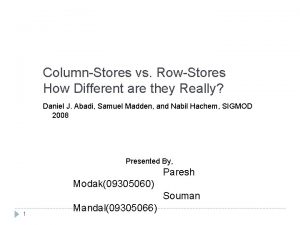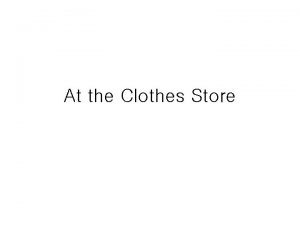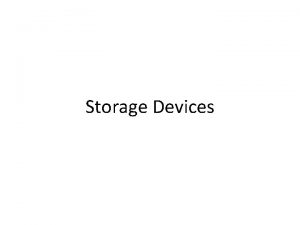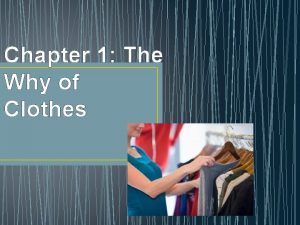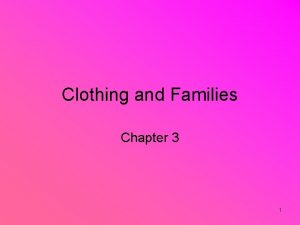Chapter 18 Caring for Clothes Clothing Storage Store









- Slides: 9

Chapter 18 Caring for Clothes

Clothing Storage Store apparel items as close as possible to the place where they will be used or put on. It is recommended that you never store clothing that is dirty. Chemicals found in deodorants, perfumes, body lotions, and perspiration can break down fibers over time. – Always sash or dry-clean garments before storing them

Removing Spots and Stains If a garment gets a spot, do something about it as quickly as possible. – Grease stains may be removed using absorbent powder, then strong detergent, then cleaning fluid. – Unidentified stains on washable fabrics should first be treated with a prewash soil and stain remover. – Stains on manufactured fibers or permanent-press fabrics are hard to remove because the fibers do not absorb water. Before removing a stain, you should: – Check the garment’s label for care information – Identify the stain – Identify the fiber content of the fabric When working with stain removal products: – A clean, well-lighted area with a hard work surface is needed – Read the manufacturer’s directions and warnings – Work in a well-ventilated area

Laundering Your Clothes Prepare clothes for laundering by closing fasteners and emptying pockets. – Agitation is the mechanical action that helps to loosen and remove soils from clothes during laundering and can cause open fasteners to catch or snag and items to fall out of pockets. The laundry products you use should be compatible with: – – – Your laundry equipment The hardness of your water The fabrics in your garments

Use the Right Water Temperatures Cold – Mainly for dark colors that bleed, for lightly soiled loads, and for delicate items. – Saves energy costs – Helps prevent fading and shrinkage – Less sanitizing effect and cleaning performance Warm – Provides good cleaning for most wash loads – Comfortable for the hands – Good for washing manufactured fibers, permanent-press, and non-colorfast fabrics Hot – Used for white and colorfast fabrics – Provides the best soil removal and sanitizing – May set stains, cause shrinkage, fade colors, and encourage wrinkling in some fabrics

Choose Correct Products Detergents are granular or liquid laundry products made synthetically from chemicals that suspend and hold dirt and grease away from clothes during washing. – Surfactants are an important ingredient in detergents because they reduce the surface tension of water. – Surfactants dissolve or suspend removed soil in water so it can go down the drain. – Builders are ingredients in laundry products that inactivate hard water minerals. Soaps are biodegradable bar or granule cleaning products made mostly from natural fats and lye. – Biodegradable means soaps have the ability to break down into natural waste products that do not harm the environment. Enzymes are proteins that speed up chemical reactions and help break down certain soils and stains into simpler forms that can be removed more easily. Bleaches are chlorine or oxygen type laundry products used to clean, whiten, and brighten fabrics. – Chlorine bleach can harm silk, wool, mohair, and spandex fibers. Fabric softeners give softness and fluffiness to washable fabrics.

Sorting Clothes Sort by color – Whites – Light colors – Dark colors Sort by kind amount of soil – – – Lightly-soiled Heavily-soiled Oily or greasy items Sort by type of fabric and garment construction – Delicates Delicate items should be washed with gentle agitation and a shorter wash time than sturdy items. – Lint-producing fabrics New towels, terry cloth robes, and chenille spreads are examples of lintproducing fabrics.

Ironing and Pressing Equipment used in ironing and pressing – – – – Iron Sleeve board Pressing mitt Ironing board Tailor’s ham Pressing cloth Velvet board Ironing is the process of using an iron to remove wrinkles from damp, washable clothing with heat and pressure – Starches are sizings used in ironing that restore body and crispness to fabrics that have become limp from laundering and wear. Pressing involves placing a heated iron on fabric and then lifting, rather than using a gliding motion – A pressing cloth is placed between the item being pressed and the iron to protect the right side of the garments and prevent shine.

Dry Cleaning Dry cleaning is the process of cleaning textile items with non-water liquid solvents or absorbent compounds. – – – Minimizes shrinkage Preserves tailoring details Maintains the fine characteristics and finishes of fabrics Services offered by professional dry cleaners – – – – Dry clean garments and other non-washable items Seasonal storage of apparel Launder and press washable items Remove spots and stains Remove pills with an industrial fabric brush Add sizings or water-repellent finishes Do minor repairs and alterations
 Dr. jean watson
Dr. jean watson Dialogue shopping for clothes
Dialogue shopping for clothes Row store vs column store
Row store vs column store Row store vs column store
Row store vs column store Shielded storage store
Shielded storage store Chapter 21 caring for head and spine injuries
Chapter 21 caring for head and spine injuries Chapter 31 caring for your career and yourself
Chapter 31 caring for your career and yourself Chapter 10 caring for yourself
Chapter 10 caring for yourself Chapter 24 caring for your career and yourself
Chapter 24 caring for your career and yourself Secondary storage vs primary storage
Secondary storage vs primary storage



